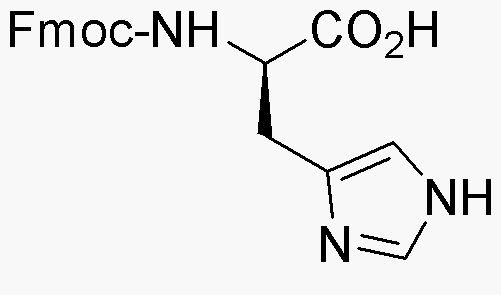Na-Fmoc-D-histidine is widely utilized in research focused on:
- Peptide Synthesis: This compound serves as a protective group in peptide synthesis, enabling chemists to build complex peptides with specific sequences while preventing unwanted reactions.
- Drug Development: It plays a crucial role in the pharmaceutical industry for developing peptide-based drugs, particularly those targeting specific receptors or enzymes, enhancing therapeutic efficacy.
- Bioconjugation: Researchers use it in bioconjugation processes to attach biomolecules to drugs or imaging agents, improving their delivery and targeting capabilities in medical applications.
- Protein Engineering: The compound is essential in modifying proteins, allowing scientists to create variants with enhanced stability or activity, which is vital for research in biotechnology.
- Diagnostics: It is also utilized in the development of diagnostic tools, particularly in assays that require specific peptide recognition, contributing to advancements in personalized medicine.
General Information
Properties
Safety and Regulations
Applications
Na-Fmoc-D-histidine is widely utilized in research focused on:
- Peptide Synthesis: This compound serves as a protective group in peptide synthesis, enabling chemists to build complex peptides with specific sequences while preventing unwanted reactions.
- Drug Development: It plays a crucial role in the pharmaceutical industry for developing peptide-based drugs, particularly those targeting specific receptors or enzymes, enhancing therapeutic efficacy.
- Bioconjugation: Researchers use it in bioconjugation processes to attach biomolecules to drugs or imaging agents, improving their delivery and targeting capabilities in medical applications.
- Protein Engineering: The compound is essential in modifying proteins, allowing scientists to create variants with enhanced stability or activity, which is vital for research in biotechnology.
- Diagnostics: It is also utilized in the development of diagnostic tools, particularly in assays that require specific peptide recognition, contributing to advancements in personalized medicine.
Documents
Safety Data Sheets (SDS)
The SDS provides comprehensive safety information on handling, storage, and disposal of the product.
Product Specification (PS)
The PS provides a comprehensive breakdown of the product’s properties, including chemical composition, physical state, purity, and storage requirements. It also details acceptable quality ranges and the product's intended applications.
Certificates of Analysis (COA)
Search for Certificates of Analysis (COA) by entering the products Lot Number. Lot and Batch Numbers can be found on a product’s label following the words ‘Lot’ or ‘Batch’.
Número de catálogo
Número de lote/lote
Certificates Of Origin (COO)
This COO confirms the country where the product was manufactured, and also details the materials and components used in it and whether it is derived from natural, synthetic, or other specific sources. This certificate may be required for customs, trade, and regulatory compliance.
Número de catálogo
Número de lote/lote
Safety Data Sheets (SDS)
The SDS provides comprehensive safety information on handling, storage, and disposal of the product.
DownloadProduct Specification (PS)
The PS provides a comprehensive breakdown of the product’s properties, including chemical composition, physical state, purity, and storage requirements. It also details acceptable quality ranges and the product's intended applications.
DownloadCertificates of Analysis (COA)
Search for Certificates of Analysis (COA) by entering the products Lot Number. Lot and Batch Numbers can be found on a product’s label following the words ‘Lot’ or ‘Batch’.
Número de catálogo
Número de lote/lote
Certificates Of Origin (COO)
This COO confirms the country where the product was manufactured, and also details the materials and components used in it and whether it is derived from natural, synthetic, or other specific sources. This certificate may be required for customs, trade, and regulatory compliance.


